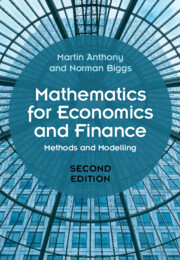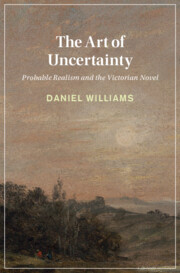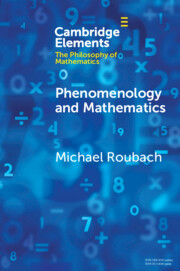99 results

Mathematics for Economics and Finance
- Methods and Modelling
-
- Published online:
- 24 May 2024
- Print publication:
- 30 May 2024
-
- Textbook
- Export citation
How Can Data Science Contribute to Understanding the Khipu Code?
-
- Journal:
- Latin American Antiquity , First View
- Published online by Cambridge University Press:
- 06 May 2024, pp. 1-20
-
- Article
-
- You have access
- HTML
- Export citation
Chapter 3 - Early Learning in Plato, Republic 7
-
-
- Book:
- Conceptualising Concepts in Greek Philosophy
- Published online:
- 25 April 2024
- Print publication:
- 02 May 2024, pp 56-73
-
- Chapter
- Export citation
Introduction
-
- Book:
- The Art of Uncertainty
- Published online:
- 29 February 2024
- Print publication:
- 07 March 2024, pp 1-36
-
- Chapter
- Export citation

The Art of Uncertainty
- Probable Realism and the Victorian Novel
-
- Published online:
- 29 February 2024
- Print publication:
- 07 March 2024
Chapter 11 - STEM education in early childhood
- from Part 2 - How can I enhance children’s learning of science?
-
-
- Book:
- Science in Early Childhood
- Published online:
- 13 December 2023
- Print publication:
- 10 January 2024, pp 163-180
-
- Chapter
- Export citation

Phenomenology and Mathematics
-
- Published online:
- 27 November 2023
- Print publication:
- 21 December 2023
-
- Element
- Export citation
10 - Scientific Communities and the Emergence of Science in Early Modern Japan
- from PART II - Economy, Environment, and Technology
-
-
- Book:
- The New Cambridge History of Japan
- Published online:
- 15 January 2024
- Print publication:
- 23 November 2023, pp 342-362
-
- Chapter
- Export citation
3 - Leading Activity and Child Development
-
- Book:
- The Cultural Mind
- Published online:
- 09 November 2023
- Print publication:
- 23 November 2023, pp 72-100
-
- Chapter
- Export citation
Fiction Beyond Words: Music in J. M. Coetzee’s Jesus Novels
-
- Journal:
- Cambridge Journal of Postcolonial Literary Inquiry / Volume 11 / Issue 1 / January 2024
- Published online by Cambridge University Press:
- 17 November 2023, pp. 19-35
-
- Article
-
- You have access
- Open access
- HTML
- Export citation
Chapter 8 - Mathematics and Computational Thinking
- from Part II - Engaging in Disciplinary Tasks in Science and Engineering
-
- Book:
- A Practical Approach to Supporting Science and Engineering Students with Self-Regulated Learning
- Published online:
- 02 November 2023
- Print publication:
- 16 November 2023, pp 131-142
-
- Chapter
- Export citation
Chapter 6 - The Pleasure of Thinking in Diverse Experiences
-
- Book:
- The Pleasure of Thinking
- Published online:
- 05 October 2023
- Print publication:
- 19 October 2023, pp 164-183
-
- Chapter
- Export citation
1 - Choice and Chaos
- from Part I - Expressive
-
- Book:
- Encounters with Islam
- Published online:
- 09 September 2023
- Print publication:
- 14 September 2023, pp 9-38
-
- Chapter
- Export citation
Chapter 14 - STEM in the primary setting
-
- Book:
- Primary Mathematics
- Published online:
- 01 September 2023
- Print publication:
- 07 September 2023, pp 297-314
-
- Chapter
- Export citation
Chapter 9 - Discipline Creativity
- from Part II - Education
-
- Book:
- Encouraging Innovation
- Published online:
- 17 August 2023
- Print publication:
- 31 August 2023, pp 103-113
-
- Chapter
- Export citation
What Mathematics and Metaphysics of Corporeal Nature Offer to Each Other: Kant on the Foundations of Natural Science
-
- Journal:
- Kantian Review / Volume 28 / Issue 3 / September 2023
- Published online by Cambridge University Press:
- 24 August 2023, pp. 397-412
- Print publication:
- September 2023
-
- Article
-
- You have access
- Open access
- HTML
- Export citation
Chapter 8 - The Cave
- from Part III - Myth and Allegory in the Republic
-
- Book:
- How Plato Writes
- Published online:
- 27 July 2023
- Print publication:
- 17 August 2023, pp 163-180
-
- Chapter
- Export citation
Chapter 8 - How can I use other learning areas to support learning in primary science?
- from Part 2 - Primary science in the classroom
-
- Book:
- Primary Science Education
- Published online:
- 30 June 2023
- Print publication:
- 15 June 2023, pp 205-240
-
- Chapter
- Export citation
Chapter 10 - How can STEM education enable students’ understanding of science concepts?
- from Part 2 - Primary science in the classroom
-
- Book:
- Primary Science Education
- Published online:
- 30 June 2023
- Print publication:
- 15 June 2023, pp 273-296
-
- Chapter
- Export citation
6 - STEM and the Democratic Aims of Mathematics Education
-
- Book:
- Educating for Democracy
- Published online:
- 20 April 2023
- Print publication:
- 27 April 2023, pp 80-100
-
- Chapter
- Export citation



